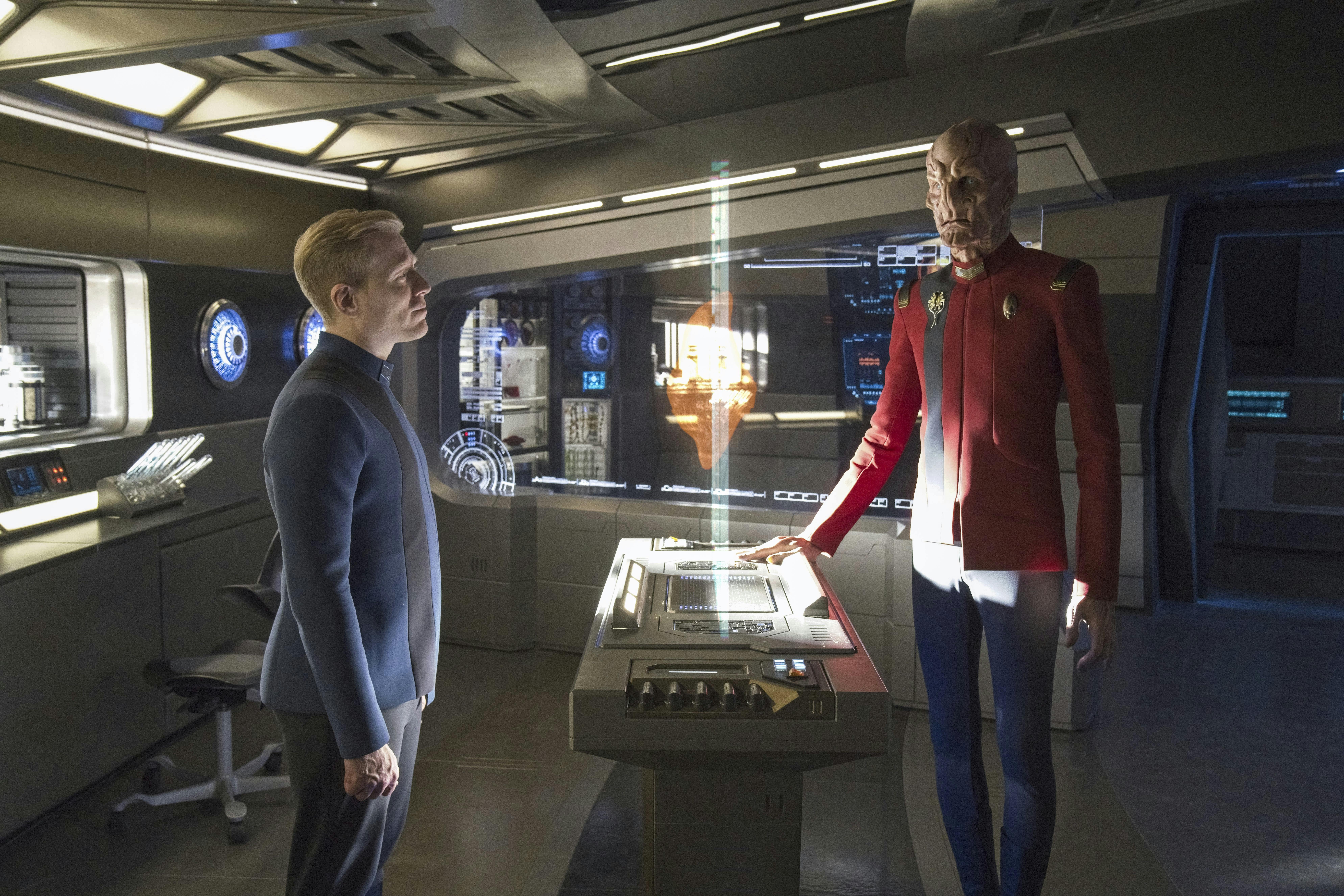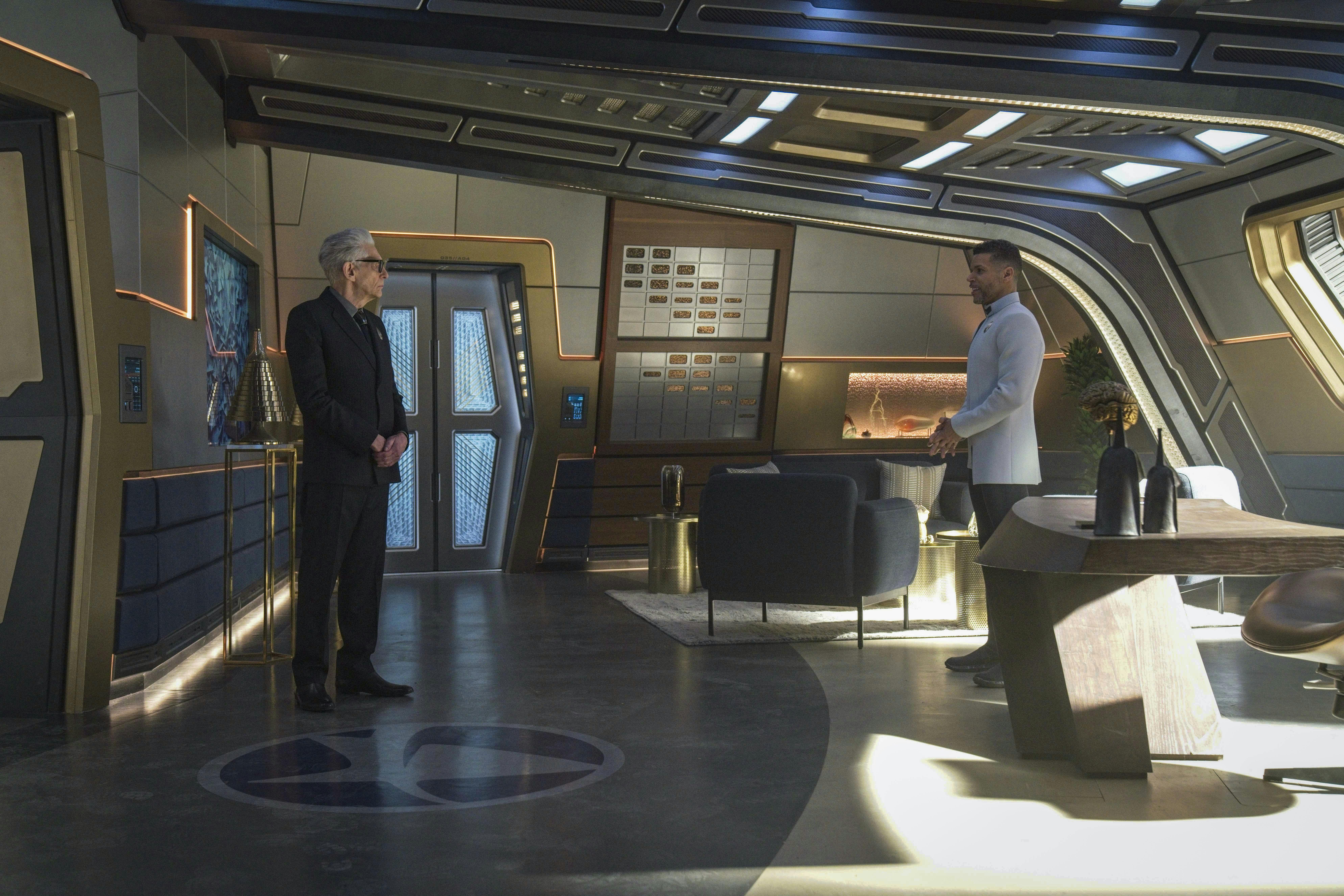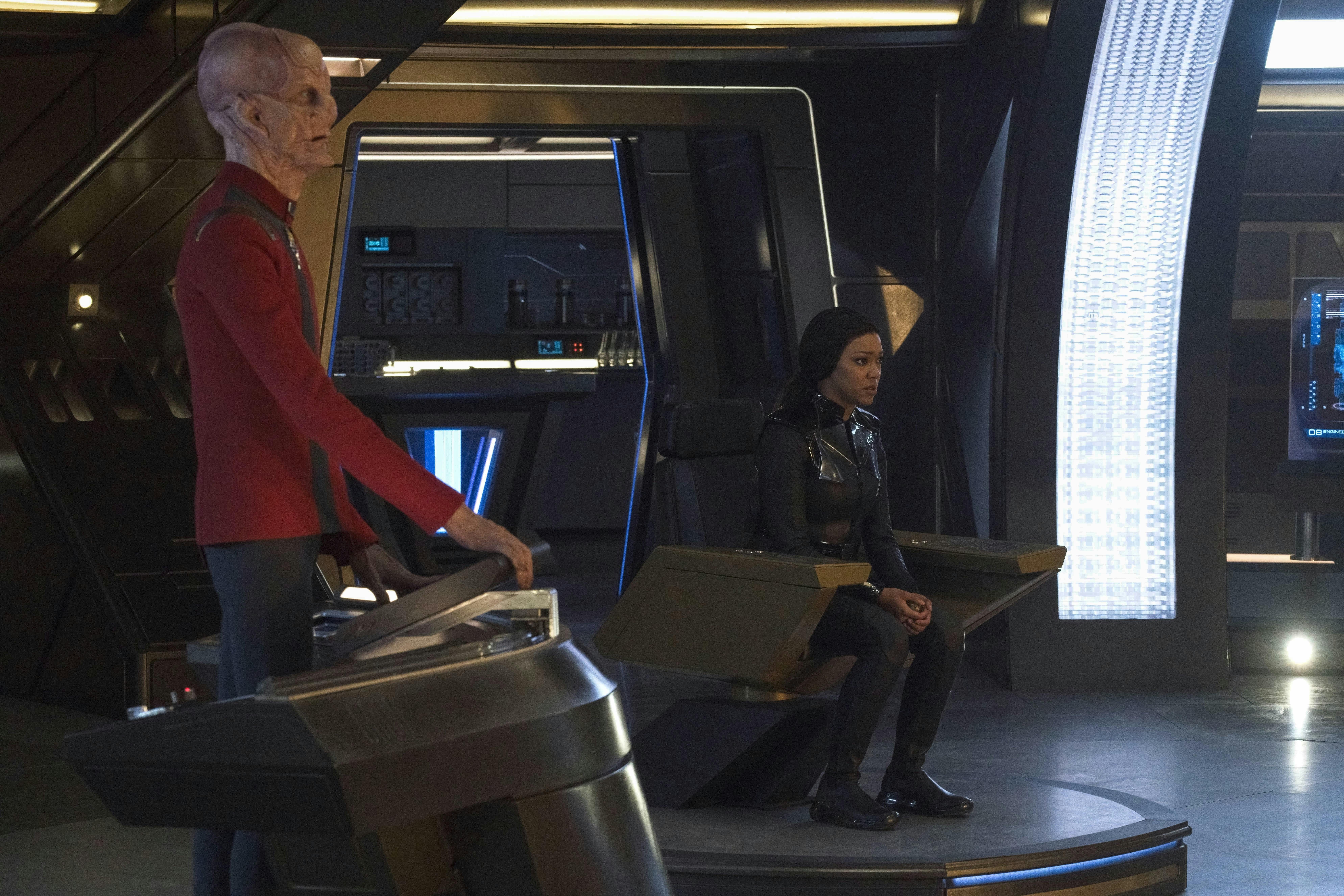Published Dec 17, 2021
Recap: Star Trek: Discovery - The Examples
The DMA threat grows in the latest episode

StarTrek.com
Spoilers for Star Trek: Discovery season four, episode five to follow.
With Ni’Var having rejoined the Federation, the starship N.S.S. T’Pau patrols near the Dark Matter Anomaly (DMA) alongside the U.S.S. Janeway. Both vessel names reference legendary leaders from the Federation’s past, but the warm feeling of nostalgia is soon replaced by one of shock as the DMA suddenly disappears. Aboard the U.S.S. Discovery-A, Paul Stamets and Jett Reno (welcome back, Tig Notaro!) scramble to figure out what just happened while looking at a galactic map depicting familiar locations (Denobula, Argelius, Wolf 359, Memory Alpha, and many more).
When the DMA reemerges 1,000 light years from its previous position, the Discovery crew realizes that the anomaly must be artificial. Admiral Vance lists an iconic roster of advanced Star Trek species - the Metrons from The Original Series episode “Arena,” survivors from the Iconian homeworld that was explored in The Next Generation’s “Contagion,” and the Nacene, the race of Caretakers who transported U.S.S. Voyager to the Delta Quadrant in the 24th century. On the other hand, Vance rules out the Q Continuum, who apparently haven’t made contact with the Federation in 600 years. Starfleet classifies the DMA’s hidden perpetrators as Species 10-C.
The DMA’s new trajectory puts it on course for an Akaali asteroid colony in former Emerald Chain territory, but the Federation is unable to accurately predict if the settlement will be destroyed. Vance orders Discovery and all nearby vessels to launch a precautionary evacuation, while the scientist developing the new generation spore drive, Ruon Tarkia is assigned to help Stamets study the DMA. Tarka has apparently been developing that propulsion system alongside Aurellio, the former Emerald Chain scientist last seen in “That Hope Is You, Part 2.”

StarTrek.com
As the evacuation begins, Captain Burnham speaks to the Akaali Magistrate, a political leader used to operating under the Chain’s oppressive regime who reveals that he plans to leave six prisoners behind. Known as “The Examples,” these inmates serve as warnings to prevent other colonists from breaking the law. Gen Rhys requests to lead the beam up of the Akaali, who were last seen as a pre-warp species in Enterprise’s “Civilization,” while Burnham and Book plan to go to the prison and personally rescue The Examples.
Risan scientist Tarka arrives, and while his home is typically known as a pleasure planet filled with friendly inhabitants, he immediately ruffles feathers with his direct demeanor. Stamets notes that, when the DMA disappeared, it seemed to collapse into some sort of device, a mechanism which he believes may control the anomaly. Tarka proposes they create a miniature model of the DMA controller in engineering, despite the dangers of creating a small wormhole on the ship.
Approaching the prison, Burnham and Book encounter a defense system left over from the Emerald Chain: synthetic beetles that act as mobile landmines. The captain disables the devices just in time, allowing the duo to enter the facility and meet the inmates, each of whom was sentenced to life for petty crimes. Felix, one of The Examples, questions the Federation’s intentions, going so far as to demand that Burnham guarantee they will not be returned to Akaali custody.
Meanwhile, Dr. Culber takes a break from counseling evacuees to converse with Kovich, who determines that Culber had requested the meeting to hear some of the bespectacled man’s unique brand of absolute candor. Assuming a dual role has taken its toll on Culber, forcing the medical officer to admit that he feels he’s been lying to his patients by telling them that everything will be okay. Kovich bluntly points to Culber’s resurrection in “Saints of Imperfection” as the origin point for the doctor’s savior complex, recommending that Culber find a new outlet for rest and relaxation.

StarTrek.com
Stamets, Reno, and Tarka test the model DMA controller, arguing that any data they collect could help them uncover who made the DMA and how to stop it. Unfortunately, they are only able to acquire a fraction of the information as Saru elects to end the experiment right before the containment field fails.
Back at the prison, Burnham has the prisoners request political asylum so that the Federation can review their cases and commute their sentences. Before leaving, Felix quietly confides in Michael, explaining that he actually did murder someone. During his crime, Felix stole an orb that contained information about his victim’s heritage, a precious heirloom that he hoped to eventually return to the man’s daughter.
Once outside the facility, Felix ensures that Burnham keeps her word and beams up the other five prisoners. However, Felix resolves to stay as penance for his transgression, willing to either return to jail or be killed by the DMA. Still hurting from the loss of his family and Kwejian in “Kobayashi Maru,” Book pleads with Felix in the hope of changing his mind. Felix doesn’t waver, asking the captain to return the orb to his victim’s daughter. Book and Burnham beam to Discovery, where the bridge crew can only watch as the DMA pushes the colony into the sun.
Zora, the entity forged from the union of Discovery’s computer and the Sphere data from season two, confirms that the Akaali woman who Felix sought is one of the refugees aboard her ship, so the captain is able to return the orb. Burnham is nevertheless surprised to learn that Zora has recently begun to feel emotions, a revelation that could have tremendous ramifications. Tarka finds Book in the Forward Lounge, where the Kwejian finds out that the Risan knows the DMA was not created by the Metrons, Nacene, or Iconians. Tarka explains that his calculations indicate the real DMA controller has an energy source equivalent to a hypergiant star.

StarTrek.com
Packed with references to previous eras of Star Trek, “The Examples” turns Season 4’s attention to the looming threat of the DMA, as our crew studies its controller and witnesses the anomaly’s devastating impact on the Akaali colony. Mysteries abound, ranging from the identity of the DMA’s creators to Zora’s evolution, and Book even spots what appears to be a scar from the Emerald Chain implants, previously seen in “Scavengers,” on the back of Tarka’s neck. Much like the DMA’s trajectory, we are left wondering where the rest of season four will take us. Stay tuned as we continue to boldly go…
Jay Stobie (he/him) is a freelance writer and consultant who has contributed articles to StarTrek.com, Star Trek Explorer, and Star Trek Magazine, as well as to Star Wars Insider and StarWars.com. Jay serves as a BoldlyGo Campaign Ambassador for The Roddenberry Foundation. Jay can be found on Twitter and Instagram at @StobiesGalaxy.
Star Trek: Discovery currently streams exclusively on Paramount+ in the U.S. Internationally, the series is available on Paramount+ in Australia, Latin America and the Nordics, and on Pluto TV in Austria, France, Germany, Italy, Spain, Switzerland and the United Kingdom on the Pluto TV Sci-Fi channel. In Canada, it airs on Bell Media’s CTV Sci-Fi Channel and streams on Crave. Star Trek: Discovery is distributed by ViacomCBS Global Distribution Group.

